‘It’s an ugly scrabble of rocks, but to a kid it was an unbridled treat’: Irvine Welsh on Silverknowes beach, Edinburgh
I’m very fortunate to reside in Miami Beach. I’m five minutes’ walk from that golden-sanded paradise of the same name, habitually strolling down the street right on to the front of that shimmering blue Atlantic Ocean. Above, the only blemish on the azure sky is the white slash of a jumbo jet’s trail as it brings another set of already tanned and buffed tourists to those shores. They stride the beach, those implausibly fit birds and muscled and cut geezers, their ruthless gym-and-diet regime undertaken for months simply to look the part for this fortnight under the tropical rays. I love living here, and I love beaches in general.
But my favourite shoreline remains the one that helped fashion the milk-bottle skin and beer gut that marks me as the perennial outcast in such rarefied south Floridian surroundings. Yes, forgive the nostalgic indulgence, but I’m going back to the council scheme of Muirhouse, and our much loved local beach at Silverknowes. OK, I’ll permit that on first glance this “beach” is an ugly, gale-battered scrabble of rocks that hugs the Forth Estuary on its sludgy journey out to the cold, unforgiving North Sea.
Yet, whereas the over-trained eye sees only desolation, the young Welsh and his cohorts, like Messrs Campbell and Webster (who are still stuck with me to this day), envisioned only box-canyon arenas where washed-up crabs might be induced to do battle with each other to death, under our cruel Roman emperor-like supervision. In the sloping forested area that led down from our scheme at Muirhouse to the esplanade, we saw abundant Tarzan swings. Nestling on the edge of this jungle, the mysterious grand gothic mansion, spilling through the mist, which so captivated and excited us. In our imaginings, it was a haunted house (yes, scheme kids back then often aspired to an Enid Blyton world) when in reality it contained the administrative offices for the Scottish Gas Board. On seeing our urchin faces pressed up against the glass windows, the Spectre-like cell of enemy operatives, disguised as clerks, would shout, “Get tae fuck!” as we attempted to scupper their secret missile-launching plans. In the sewage outlets springing from the banked slopes into the river, we constructed elaborate dams, splashing merrily in the effluent waste derived from the weekend activities of Muirhouse’s best men in the Gunner and Doocot taverns.
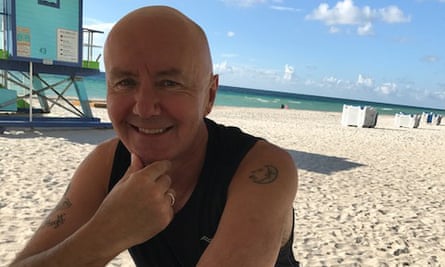
To a kid, Silverknowes beach was simply an unbridled treat. This was enhanced exponentially if you had money for an ice-cream cone from the solitary retail outlet along the winding expanse of the esplanade.
The Seashell cafe was modelled on the architecture of the nearby scheme, with a nod to the oncoming pillboxes that dotted Cramond Island, designed to deter Nazi U-boats, and which came of age in the post-pill era as impromptu bordellos. The island was the haunt of shaggers who would get “accidentally” stranded there for the night when cut off by the incoming tide. The most frantic debates of youth were often centred around when was the best time to hit the island with the object of your desire.
Of course, you had to be careful what you wished for. My buddy Steve was more successful than most in these early seduction endeavours, and after he and his companion had spent most of the night on the island, snogging and canoodling, the lifeboat rescue search party arrived heroically to pluck them off the rock.
On reaching the shoreline, Steve’s weak words to the girl’s irate father – “The tide cut us off…” – were met with the response: “Cut yis oaf? I’ll cut your fucking baws oaf right now!”
While my own seduction attempts were met with nothing more harrowing than a slap in the pus, it’s such incidents that make me delighted that the hazards of youth are long gone. But not the beach that boasts the sign, “These mussels are unfit for human consumption.” Because, despite warm sun, cool bars, and the fact that it’s much easier to get a hot date on Miami Beach, Silverknowes will always be the strand extraordinaire for me.
‘This place rings with the cries and shouts of my children’: Sebastian Barry on Ross back beach, County Mayo
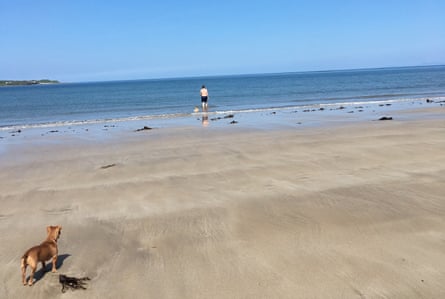
I know a strand in the soft paradise of north Mayo and I am half-reluctant to tell you about it. Recently a sign has gone up to say “not suitable for swimming”, but I have been swimming there innocently for years. When the tide is out, you have to wade almost to Newfoundland to get depth. When the tide is in, you have deep cold water off the steeply plunging sand. Maybe it’s the Palmerstown river running down into the strange bay at Rathfran that affects this whole run of water and creates a certain danger – certainly a muscled current runs the length of it, parallel to the beach, when the tide is going out. A huge sky stares down at you, and you are usually alone, suddenly singular, the odd thing out in the vast and simple brushstrokes of colour that constitute this paradise.
At the far end, the whale-shaped hump of land dwindles to sharp, shardy rocks, with Ross strand and Killala invisible beyond. Between these two points, the wide acres of dunes and marram grass, a little lake with a butcher’s dozen of swans, arrogant in their safety there, then sandy fields with their impediment of cows, crows, swifts. More rarely, perhaps, after the long, fenced path from the little car park, are, here and there, perfectly at home but exotic as all hell, rare helleborine orchids, bee orchids, flowers I am almost afraid to name for fear of thieves going down to root them up.
This place seems to ring now with the receding cries and shouts of my children as they cascade down the dunes, making their giant steps, screaming, vigorous, eternal. Those children, who are now in their 20s, have left their music there to echo in their father’s ears as he passes by. Damp togs in damp towel under his arm. The dunes one separate country, the uppity swans their kings and queens, then the heart-opening strand, the mysterious builder’s level of the sea beckoning. Sixty-one-year-old scribbler changing demurely with his towel on the empty beach and rushing down to meet that generous water, my French bulldog making a huh-huh sound as she rushes with me. Then the sudden admonition of the cold, the life-giving, time-arresting embrace of the old Atlantic, memories stirred of our deepest origin, the truly pre-linguistic happiness of diving under, old fishlike states restored, exultantly. Toes going white with chilly fright, but the head violently cleared, windows and doors thrown open to the air, the land both rushing away and rushing in, everything cancelled, everything written in.
‘I didn’t bother taking anything so optimistic as a swimsuit’: Kamila Shamsie on Camber Sands, East Sussex
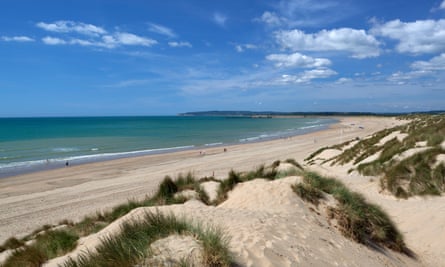
One summer when I was a child, visiting England with my family during the school holidays, my mother announced that we were going to see friends who lived by the sea, and just a short distance from a beach. My life in Karachi had taught me there wasn’t anything more pleasurable than leaving behind the noise and enclosed spaces of the city to run across warm sand and plunge into the endless blue. But when we arrived at this alleged beach of England, the water was too cold even to dream of entering it, and there wasn’t any sand at all, only pebbles.
For years thereafter, the phrase “English beach” would make my lip curl. It was a source of sadness. I loved England, but its cold shingle beaches marked a point at which love had to turn away, rejected and rejecting. So when I was in my 20s, back in London during the summer of 2001, and my friend Juni said she would take my sister and me to a lovely beach where we could swim and sit on the sand, I responded with scepticism. For starters, I said, there wouldn’t be any sand. “But it’s called Camber Sands,” she said with what seemed to me naive faith that in England things always meant what they appeared to mean.
I didn’t bother taking anything so optimistic as a swimsuit. We caught the train to Rye, one blazing hot Sunday, and on arrival looked around for taxis to take us to Camber Sands. There were no taxis. We called the local minicab companies. No one answered. We trudged to the bus stop and discovered the next bus wasn’t due for an hour. Well, then, we would walk. So we walked, and we walked. The first person we asked for directions told us to continue straight along the path we were on; that seemed easy enough. The second person said, dubiously, “It’s a long way away.” We were hot and thirsty, and the thought that we were enduring this for shingle and icy waters was unendurable. But then an AA breakdown truck appeared and agreed to give us a ride to this alleged beach.

There was sand. Soft, brown sand, warm beneath our feet. And there was the endless blue, at a temperature so perfect, I could have wept to enter it. There was no question of keeping out of it merely because we had no swimsuits. In we plunged. It was glorious. England was glorious. We swam and we floated and we stayed in that water until something familiar bobbed towards us, which turned out to be our bags, which we’d left on the sand several feet from the water’s edge. Time to go then, while there was enough sun to dry us off and while the buses were still running. We had, of course, checked the bus times back to Rye.
Oh no, but we hadn’t checked the Sunday times, had we, and there were no more buses for the day. But a day of sun and sea and sand can’t end in tears, so we sauntered along to a coach full of French schoolchildren and asked for a lift. The teachers, unimpressed, said, “We are going to Hastings, not Rye.” We said, “We can go to Hastings”, which didn’t seem to delight the teachers, but they let us on the coach and dropped us off near the train station, where we bought tickets back to London with soggy notes, and I discovered the first ever mobile phone of my life had died.
I’ve been living in England for 10 years now, but I have never been back to Camber Sands. The scepticism, the exhaustion, the kindness of AA drivers, and then the glorious surprise of the beach I hadn’t believed possible, followed by the waterlogged phone and the surly but ultimately obliging French teachers – all that together was Camber Sands for me. So I suppose I should say, there is no going back to Camber Sands. But it’s a comfort to know it’s out there, making this England feel just that much more like home.
‘The polished flat pebbles here skip across the silvered water’: Cerys Matthews on Aberfelin beach, near Trefin, north Pembrokeshire
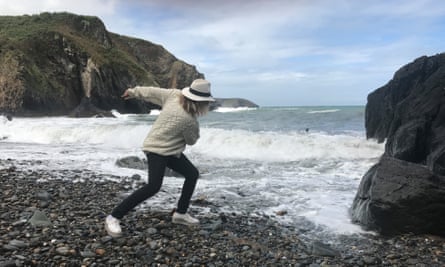
The beach that means the most to me is one I’ve known all my life. Many branches of my family have spent time there, my parents still live on the cliffs above and my children race with the tide. It’s a rocky inlet with a cave under the cliff, and in the cave my father’s, my grandfather’s and my great-grandfather’s initials are engraved in the dark wet walls.
A poem has been written about the mill from which the beach gets its name – Melin Trefin, by William Williams (Crwys) – and there’s a rumour in the family that the last miller mentioned in the poem was indeed my great-grandfather, John Phillips Maddocks.
There’s a routine to what I see, think and do when I arrive here. I learned it from generations gone by. To get here, you’ve crossed over mainland Britain, working your way as far west as you can get. You’ll be 60 miles from Rosslare and, standing on the cliffs on the coastal road, staring over the Irish Sea, you might catch a glimpse of the crossing ferry. You might even see old Erin, on a clear day.
Now walk down to the seashore: past the valerian, the sloe bushes, the curdling run of water that used to turn the old mill wheel, the workers’ cottages to the right, the brambles, gorse and huge flat slate bench. It brings you to another stream of water, to your right, a slower one where watercress grows, and over which a bridge might be taken, bringing the walker to the Grappley, a lofty stage over Aberfelin. It’s thick with succulent grass, where, according to my great-aunt, now long deceased, the locals would picnic on holidays, and the chapel choir met each Sunday.
But no picnic for us: we won’t be taking the bridge. Continue straight, keeping the ruined mill close to your left. Marvel at this seat of industry, which fed the whole area with the flour it produced, now just crumbling walls around the grinding stones laid down some 500 years ago. It roared and snored when it turned; now, of course, the only symphony is the wheeling seagulls and crashing waves.
Pick your way down the narrow slate path. Soon you’ll reach ground level, fill your lungs with the sour, salty air, pad through the fat stench of bloated bladderwrack and kelp, swatting through flies, and stop at the sea edge.
Look down: no white shell sands but the mottled black, greys and reds of a slate beach, the odd glimmering white quartz.
You’ll bend to pick up polished flat pebbles, heap them in your pocket, look west and, with steely gaze, aim and shoot one skipping across the silvered surface of the water. And repeat. Soon you’ll see them: Aunty Glen in bloomers, Uncle Gwyn in full old-school bathers waving to come and join them in the freezing depths. They met here, courted, sang on the Grappley, were betrothed, lived and died, and here their souls sing on. I pick up a stone, scratch on it “Glenys + Gwyn” and throw it to the waves.
‘My partner and baby braved the gales like pros’: Emma Jane Unsworth on Sango Bay, Durness, Scotland
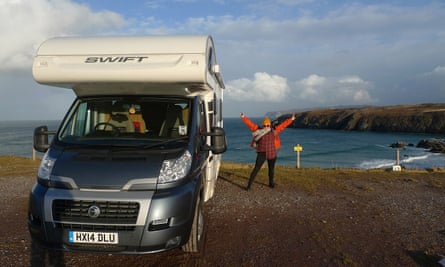
I live in Brighton, so I’m probably being terribly treacherous not saying Brighton beach is my favourite, but you know what? It does nothing for me. The seagulls are hooligans, the beach itself is pebbly – and, as I frequently argue with my partner, a pebbled beach is not a beach. Especially not for the sciatic.
No, my beach of choice is in Durness, up on the very top of mainland Scotland: Sango Bay, a chock of golden sand set against the crashing Atlantic, surrounded by ragged cliffs. Around the corner is the aptly named Cape Wrath, the most north-westerly point of the Scottish mainland. The sea is wild up there. In fact, the whole place is wild. At Durness, monolithic boulders break the waves as the tide comes in. The land is covered in scrubby, half-burnt grass, ripped by the wind. On the steep path down to the beach, you must watch your footing. But the best beaches are those you have to work for: the tricksy coves, the dune-locked lagoons. Durness is exposed, elemental, raw. It doesn’t pander to the sand-seeker.
Strangely, amid all that crashing and lashing, I have found much peace. I have done a lot of writing, a lot of thinking, in a motorhome parked at the campsite on the top of the cliffs at Sango Bay. Nature at its least congenial calibrates your perspective. Besides, there’s so much beauty. The shocking orange beaks of oystercatchers along the shoreline. The sand embossed with the looping footprints of hardier dog-owners and their hounds.
Take a short walk east, and you find Smoo Cave, a conjoined seawater and freshwater cave with a thundering waterfall. It was at Durness I saw my first white horses, just like on the Guinness advert. A big swell buffeted by an offshore wind, the spume off the top of the wave blowing back in mane-like trails.
At night, it’s even more dramatic. I’ve had a few hairy times there, mainly because I like to go motorhoming in winter. I recall a particularly vicious storm, rain on the roof like gunfire, the wind coming at the side of the van with such force, it felt as though two of the van’s wheels were lifting off the ground. I lay in my bunk over the cab, frantically Googling the Beaufort scale, trying to work out what sort of strength wind would be necessary to push a three-and-a-half-tonne motorhome off a cliff. (Turns out, a hurricane. However, the picture accompanying “hurricane” was a tidal wave. Unhelpful.) I pondered the inner workings of the handbrake. How reliable was a modern handbrake, exactly? “Maybe I’ll just put it in gear,” I muttered to myself, getting up. I moved down from the bunk and slept in the back, whisky in hand.
Have I mentioned that the post office next to the campsite sells beers from the Orkney Brewery? Its Dark Island and Red MacGregor brews are particularly well suited to a blustery evening on a clifftop. I like to cheers the horizon, in the direction of Orkney, 100 or so miles north-east. I went up to Durness most recently with my partner and baby, who braved the February gales like pros. I actually think my son quite liked it, as the van rocked to and fro like a massive cradle, plus all that meteorological white noise.
I wonder how much of the pull of Durness is the human urge to go up and up and up, as far as possible, to the edge, and teeter awhile. I always leave feeling recharged. There are more beautiful beaches in Scotland – Achiltibuie, near the Summer Isles; Arisaig, where they filmed Local Hero, to name two close to my heart. But none is as magnificent as Durness, none as weathered, none as squally. Fling my ashes there in an empty bottle of Red MacGregor, would you?
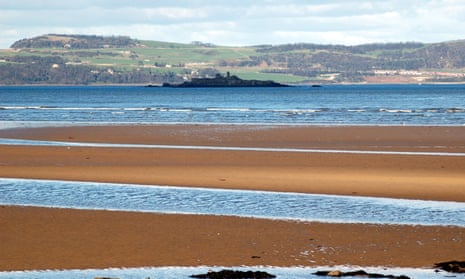
Comments (…)
Sign in or create your Guardian account to join the discussion